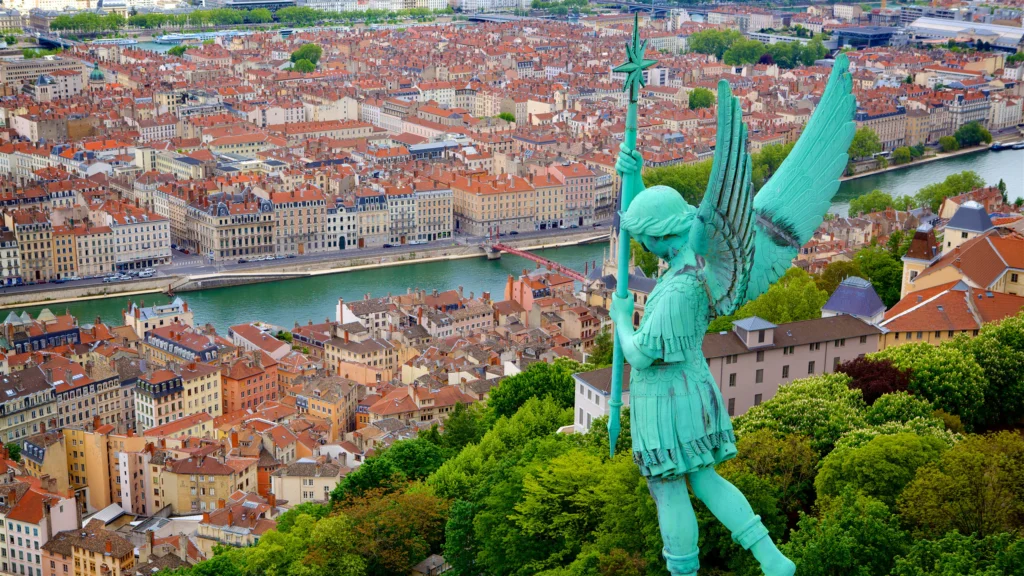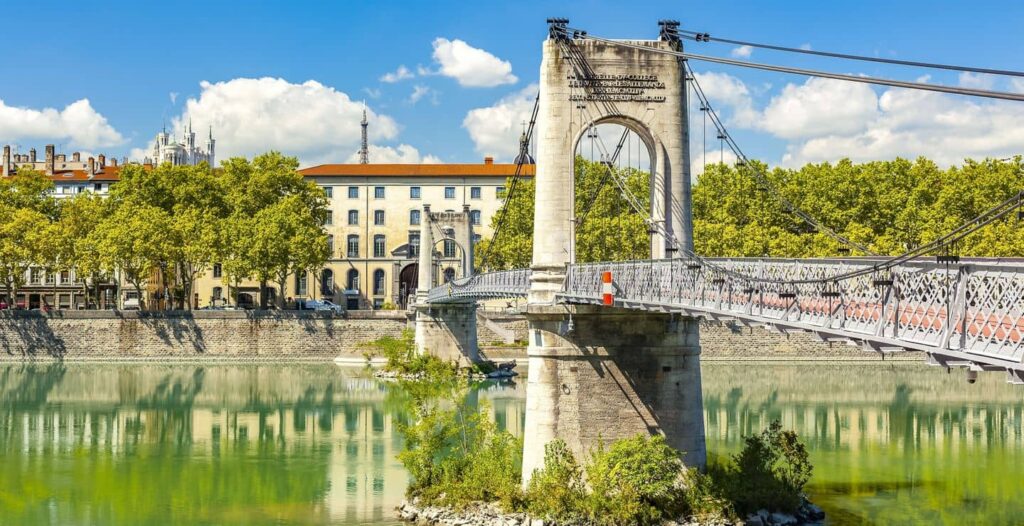
Lyon[c] is the third largest city of France and second largest urban area.[d] It is located at the confluence of the rivers Rhône and Saône, to the northwest of the French Alps, 391 km (243 mi) southeast of Paris, 278 km (173 mi) north of Marseille, 113 km (70 mi) southwest of Geneva, 58 km (36 mi) northeast of Saint-Étienne.
The City of Lyon had a population of 522,250 at the Jan. 2021 census within its small municipal territory of 48 km2 (19 sq mi),[14] but together with its suburbs and exurbs the Lyon metropolitan area had a population of 2,308,818 that same year,[7] the second most populated in France. Lyon and 58 suburban municipalities have formed since 2015 the Metropolis of Lyon, a directly elected metropolitan authority now in charge of most urban issues, with a population of 1,424,069 in 2021.[15] Lyon is the prefecture of the Auvergne-Rhône-Alpes region and seat of the Departmental Council of Rhône (whose jurisdiction, however, no longer extends over the Metropolis of Lyon since 2015).
The capital of the Gauls during the Roman Empire, Lyon is the seat of an archbishopric whose holder bears the title of Primate of the Gauls. Lyon became a major economic hub during the Renaissance. The city is recognised for its cuisine and gastronomy, as well as historical and architectural landmarks; as such, the districts of Old Lyon, the Fourvière hill, the Presqu’île and the slopes of the Croix-Rousse are inscribed on the UNESCO World Heritage List. Lyon was historically an important area for the production and weaving of silk. Lyon played a significant role in the history of cinema since Auguste and Louis Lumière invented the cinematograph there. The city is also known for its light festival, the Fête des Lumières, which begins every 8 December and lasts for four days, earning Lyon the title of “Capital of Lights”.
Exploring Lyon: A Journey Through France’s Culinary and Cultural Capital
Nestled between the Rhône and Saône rivers in southeastern France, Lyon is a city steeped in history, culture, and, most notably, gastronomic excellence. Recognized as a UNESCO World Heritage site, Lyon offers a captivating blend of ancient Roman ruins, Renaissance architecture, bustling markets, and a world-renowned culinary scene. Whether you’re a history buff, a foodie, or a lover of art and architecture, Lyon has something to offer every traveler. With its rich cultural tapestry and vibrant neighborhoods, this city invites exploration and discovery.
History of Lyon: From Ancient Rome to Modern Day
1. Lyon’s Roman Origins: Lugdunum
Lyon’s story begins in 43 BC when the Romans founded the city as Lugdunum, the capital of the Three Gauls. Positioned at the confluence of two major rivers, the Rhône and the Saône, Lyon became a vital commercial hub in the Roman Empire. The city quickly grew into a center of political and economic power, with impressive infrastructures like the Roman amphitheaters and aqueducts, many of which can still be visited today.
The remains of this ancient period are well-preserved, particularly on the Fourvière Hill, where you’ll find some of the most significant archaeological sites, including the Roman Theaters and the Musée Gallo-Romain. The legacy of Lyon’s Roman past continues to shape the city’s identity, blending ancient history with modern vibrancy.
2. Medieval and Renaissance Lyon: A Flourishing Trading Center
During the Middle Ages and Renaissance, Lyon flourished as a center of commerce and banking. Located at the crossroads of Europe, the city attracted merchants and bankers from across the continent. The wealth that poured into Lyon during this time is evident in its architectural landmarks, particularly in Vieux Lyon, one of the largest Renaissance districts in Europe.
The city’s rise as a major trade center also brought with it an influx of artisans, including silk weavers, whose legacy continues in Lyon’s silk industry today. This period also marked the beginning of Lyon’s reputation as a gastronomic center, with its bustling markets and inns catering to traders and travelers.
3. Modern Lyon: Industry and Innovation
By the 19th century, Lyon had evolved into a major industrial city, particularly in the silk trade, which dominated its economy. The invention of the Jacquard loom revolutionized the silk industry, turning Lyon into a global leader in textile production. However, the city’s growth also brought social unrest, with the Canut Revolts of the 1830s, where silk workers protested against poor working conditions.
In the 20th and 21st centuries, Lyon has continued to evolve, balancing its rich historical heritage with modern innovation. It has become a center for banking, biotech, and education, while maintaining its position as the culinary capital of France.
Iconic Landmarks of Lyon

Lyon is filled with remarkable landmarks that tell the story of its rich history and cultural significance. Whether you’re exploring ancient Roman ruins or strolling through Renaissance squares, Lyon’s architecture and history come to life at every turn.
1. Fourvière Hill: Lyon’s Historic Heart
Fourvière Hill is one of the most iconic and historically significant areas in Lyon. Perched high above the city, it offers spectacular views of the surrounding landscape, as well as some of the city’s most important landmarks.
- Basilica of Notre-Dame de Fourvière: One of Lyon’s most recognizable landmarks, the Basilica of Notre-Dame de Fourvière dominates the city skyline. Built in the late 19th century in a Romanesque-Byzantine style, the basilica is a symbol of Lyon’s religious heritage. Visitors can tour the opulent interior, which is adorned with intricate mosaics, stained glass, and marble, or climb to the rooftop for panoramic views of the city.
- Roman Theaters: On Fourvière Hill, you can explore the well-preserved ruins of the Ancient Roman Theater and the Odeon, both dating back to the 1st century BC. These theaters once hosted Roman spectacles and are still used today for performances during the Nuits de Fourvière festival, a summer event featuring music, theater, and dance.
- Musée Gallo-Romain: Located near the Roman ruins, the Musée Gallo-Romain provides an in-depth look at Lyon’s Roman history, showcasing artifacts such as mosaics, statues, and everyday objects from the ancient city of Lugdunum.
2. Vieux Lyon: A Renaissance Masterpiece
Vieux Lyon, or Old Lyon, is one of the largest Renaissance districts in Europe and is a UNESCO World Heritage site. This charming neighborhood is characterized by its narrow cobblestone streets, pastel-colored buildings, and hidden passageways called traboules.
- Traboules: One of the most unique features of Vieux Lyon is its traboules, a network of secret passageways that run through buildings and courtyards. Originally used by silk workers to transport goods between workshops, these hidden corridors offer a fascinating glimpse into Lyon’s past. Today, many of these traboules are open to the public and can be explored on foot.
- Saint-Jean Cathedral: At the heart of Vieux Lyon lies the Cathédrale Saint-Jean-Baptiste, a stunning example of Gothic and Romanesque architecture. The cathedral is known for its 14th-century astronomical clock, which still chimes several times a day.
- Place des Terreaux: A short walk from Vieux Lyon takes you to the Place des Terreaux, a bustling square that is home to the Hôtel de Ville (City Hall) and the Fountain of Bartholdi, a grand sculpture designed by the same artist who created the Statue of Liberty. The square is a lively hub for both locals and tourists, offering plenty of cafés and shops to explore.
3. Presqu’île: The Beating Heart of the City
The Presqu’île is the lively peninsula between the Rhône and Saône rivers and is Lyon’s commercial and cultural heart. This area is filled with elegant 19th-century buildings, chic boutiques, theaters, and bustling squares.
- Place Bellecour: One of the largest public squares in Europe, Place Bellecour is a central meeting point in Lyon. The square is dominated by a statue of King Louis XIV on horseback, and it is surrounded by shops, cafés, and restaurants. It’s also a great starting point for exploring the rest of the Presqu’île.
- Rue de la République: This wide, pedestrian-friendly street runs through the heart of the Presqu’île and is one of the best places for shopping in Lyon. From international brands to local boutiques, you’ll find a wide array of stores along this bustling boulevard.
- Opéra Nouvel and Place des Célestins: The Opéra Nouvel, Lyon’s grand opera house, is located in the Presqu’île and is a stunning example of 19th-century architecture with a modern twist. Nearby, Place des Célestins is home to the Théâtre des Célestins, one of Lyon’s most prestigious theaters.
4. Croix-Rousse: The Silk Workers’ District

The Croix-Rousse district, perched on a hill above Lyon, was historically the center of the city’s silk-weaving industry. Known as the “working hill” (as opposed to Fourvière, the “praying hill”), Croix-Rousse offers a different perspective on Lyon, with its steep streets, artisan workshops, and bohemian atmosphere.
- La Maison des Canuts: This small museum offers a fascinating look into the history of Lyon’s silk-weaving industry. Visitors can learn about the evolution of silk production, the invention of the Jacquard loom, and the Canut revolts, where silk workers protested for better working conditions.
- Mur des Canuts: The Mur des Canuts is one of the most famous trompe-l’oeil murals in Lyon, depicting the daily life of silk workers in the Croix-Rousse district. The mural is a stunning example of Lyon’s tradition of street art, which can be found throughout the city.
5. Parc de la Tête d’Or: Lyon’s Green Oasis
One of the largest urban parks in France, Parc de la Tête d’Or is a sprawling green space that offers a peaceful escape from the city. The park features a large lake where visitors can rent paddleboats, a botanical garden, a rose garden, and even a zoo. It’s the perfect spot for a leisurely stroll, a picnic, or a family outing.
- Botanical Garden: The Jardin Botanique de Lyon is located within the park and is home to thousands of plant species from around the world. The greenhouses are particularly impressive, featuring tropical plants, cacti, and a collection of rare orchids.
Lyon: The Gastronomic Capital of France
Lyon’s reputation as the gastronomic capital of France is well-deserved. The city is home to a remarkable array of restaurants, bouchons (traditional Lyonnaise eateries), markets, and world-renowned chefs. Whether you’re sampling local delicacies at a bouchon or dining at a Michelin-starred restaurant, Lyon’s food scene is an unforgettable experience.
1. Bouchons Lyonnais: A Taste of Tradition
A visit to Lyon wouldn’t be complete without dining at a bouchon, a traditional Lyonnaise restaurant that serves hearty, rustic dishes. These eateries were originally established to serve silk workers, and they continue to offer dishes that reflect the city’s working-class roots.
- Typical Dishes: At a bouchon, you can expect to find dishes such as quenelles de brochet (pike dumplings in a rich sauce), andouillette (a sausage made from pork intestines), gras double (tripe), and salade lyonnaise (a salad made with frisée, bacon, poached eggs, and croutons). Lyon’s cuisine is known for its use of offal and hearty, flavorful ingredients.
- Famous Bouchons: Some of the most famous bouchons in Lyon include Le Café des Fédérations, Chez Hugon, and Daniel et Denise. These restaurants offer an authentic Lyonnaise dining experience in cozy, unpretentious settings.
2. Les Halles de Lyon Paul Bocuse: A Food Lover’s Paradise
For an unparalleled gourmet experience, head to Les Halles de Lyon Paul Bocuse, the city’s premier food market named after the legendary chef Paul Bocuse. Les Halles is a food lover’s paradise, featuring stalls selling everything from fresh produce and seafood to artisanal cheeses, charcuterie, and pastries.
- What to Try: Don’t miss the chance to sample Lyon’s famous saucisson (dry-cured sausage), fromage de tête (head cheese), and the city’s renowned cheeses, including Saint-Marcellin and Rigotte de Condrieu. For dessert, try a tarte aux pralines, a bright pink pastry made with caramelized almonds.
3. Michelin-Starred Dining
Lyon is home to several Michelin-starred restaurants, making it a top destination for fine dining. Some of the city’s most famous Michelin-starred restaurants include:
- Restaurant Paul Bocuse: Located just outside the city center in Collonges-au-Mont-d’Or, this three-Michelin-starred restaurant is a must-visit for fans of classic French cuisine. Founded by the late Paul Bocuse, one of the most celebrated chefs in the world, the restaurant offers an exceptional dining experience.
- La Mère Brazier: This historic restaurant, founded in 1921 by Eugénie Brazier, was one of the first restaurants to receive three Michelin stars. Today, it continues to offer exquisite French cuisine with a modern twist under the guidance of chef Mathieu Viannay.
Practical Tips for Visiting Lyon
To make the most of your visit to Lyon, here are some practical tips for getting around and making the most of your trip:
1. Getting Around

- Public Transport: Lyon has an excellent public transport system that includes buses, trams, and a metro. The TCL (Transports en Commun Lyonnais) network is easy to navigate and covers most of the city. A Lyon City Card gives you unlimited access to public transport and free entry to many museums and attractions.
- Walking and Biking: Lyon is a pedestrian-friendly city, and many of its key attractions are within walking distance of each other. The city also has a bike-sharing system called Vélo’v, which is a great way to explore Lyon’s scenic streets and riverside paths.
2. Best Time to Visit
- Spring and Fall: The best times to visit Lyon are in the spring (April to June) and fall (September to October), when the weather is mild and the city’s parks and gardens are in full bloom. These seasons also coincide with key cultural events, such as the Nuits Sonores music festival in May and the Festival of Lights in December.
3. Cultural Events
- Festival of Lights (Fête des Lumières): Held every December, the Festival of Lights is Lyon’s most famous event, attracting visitors from around the world. During the festival, the city is illuminated with stunning light displays, projections, and installations that transform Lyon into a magical wonderland.
- Nuits de Fourvière: This summer arts festival takes place in the Roman theaters on Fourvière Hill and features a diverse program of music, theater, dance, and film. It’s a unique opportunity to experience performances in one of Lyon’s most historic settings.

2 Responses
vld0ez
vld0ez